The Mountain Messenger: Nevada City Studies Courthouse Complex Reuse
Nevada County plans to vacate its current courthouse complex in Nevada City by 2031, prompting discussions on the site’s future. A public meeting on January 29th explored potential uses, with a “Highest and Best Use Study” suggesting housing as the most beneficial option. The study, led by National Practice Leader Civic & Justice, David Crotty, considered community needs and financial feasibility. While many attendees supported housing, there was a consensus on preserving the historic courthouse. Proposed plans involve repurposing or demolishing the annex for housing while stabilizing the courthouse for preservation. Other suggestions included creating a parking structure, park, office space, or cultural institution. The study will be presented to the Nevada County Board of Supervisors for further consideration.
For more details on the community’s vision for the courthouse complex, read more with The Mountain Messenger.
The Amenity Effect: Enhancing The Shopping Experience
Amenities have a profound effect on the value of a building, and new unique experiences make a lasting impression for consumers, employees, hotel guests, and residents. Our mixed-use teammates set out to explore current and future amenity trends in our latest blog series, The Amenity Effect. Follow along as we dive deep into the environments where we work, shop, live, and thrive and take a closer look at the amenities that help make these environments flourish.
___________________________________________
After highlighting some thoughts on live and work, it’s time to unpack the play amenities that make up vibrant shopping destinations. Now more than ever, consumers are looking for a differentiated shopping experience, and amenities like ride share lounges, curbside pickup, and locally-driven food halls are replacing outdated mall offerings of the past.
Earlier this year, we set out to discover what experiential, new offerings shoppers were looking for by creating a retail amenity challenge in the absence of this year’s March Madness tournament. The top choice for 2020, a beer garden, highlighted consumers’ desires for unique food and beverage concepts that allow them to connect with friends and family, unwind, and tap into a more localized offering. When stay at home orders were lifted, people flocked to these venues, seeking that outdoor social ambiance.
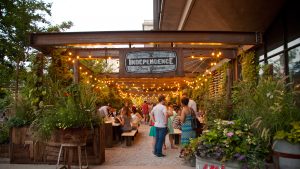
Concert venue came in at a close second, which confirms consumers’ on-going attraction to experiences over products. People are inherently drawn to music, and while it may be awhile before stadiums are selling out again, there is always a place for live music at a local shopping center.
Farmer’s market and nature trail amenities tied for third revealing consumers’ growing interest in wellness. From fresh food opportunities, to fitness, this overarching theme should continue to be a focus for every development.
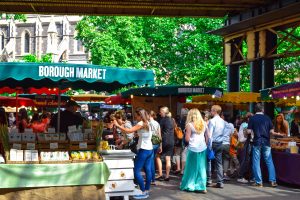
There aren’t many new malls being built, but as the big box anchors go dark and the redevelopment opportunities present themselves, we can position the right mix of amenities to enrich an existing center. NELSON works through many of these redevelopments around the country and we’re noticing that providing programming and experiences to attract and retain consumers is key.
More amenities and service offerings that enhance and bring value to a shopping destination:
- Concierge services – Providing not just valet ride share pickup areas but spaces, environments, and even lounges help improve the experience of arrival and departure from a property
- Curbside pickup and returns – Develop creative ways to utilize excess parking and retail space to set up mini distribution within shopping centers to safely and efficiently deliver merchandise to the consumer
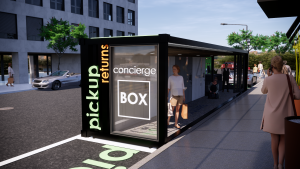
NELSON Worldwide Rendering – Pickup and Returns Concierge Box
- Hands-free shopping – Consumers shop hands-free and when they are done, arrive to a central distribution hub to gather their purchases and be on their way
- Hobby tenants –There is a place in the shopping center mix for the creative community in maker shops, places where people can come to learn how to use tools, 3D printing, computer programs and take classes to further develop their creative hobbies
- Outdoor venues – Plazas that serve up splash fountains, ice skating rinks, movies in the park, outdoor fitness, fashion shows, and artist guilds help energize a center’s value
- Patio dining – As tenants themselves seek additional outdoor dining, developers are looking for opportunities to integrate communal dining al fresco experiences
- Interactive technology – From kids play areas, to walkways and stairwells, integrating next level technology and lighting can provide for experiential exploration throughout these centers
- Crossover space/Pop-ups – Taking advantage of those in-between spaces along secondary pathways can provide opportunities for micro tenants and enhance a curated experience throughout a property
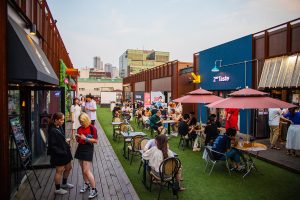
S-Factory – Seoul, South Korea
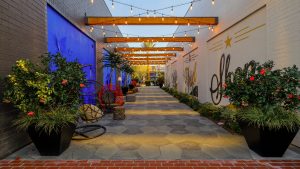
The Works – El Segundo, CA
It’s important as designers that we balance programmatic needs of the client with human nature to curate inspiring environments and experiences. Social connectivity with physical distancing may be today’s design problem, but we must plan with flexibility for a better tomorrow.
Tips for Working from Home
COVID-19 is not only changing the way we live, it’s changing the way we work. With much of the country, and world, facing uncertainty, remote working can feel like an added burden on top of an already stressful situation.
Deep. Breaths.
We are in this together and NELSON designers from across the country are sharing their favorite workplace tips, tricks, and recommendations to create an at-home office environment that feels comfortable, functional, and uniquely you.
It might not be ideal, but it’s the new normal, so let’s make the best of it!
Create a dedicated space that’s functional
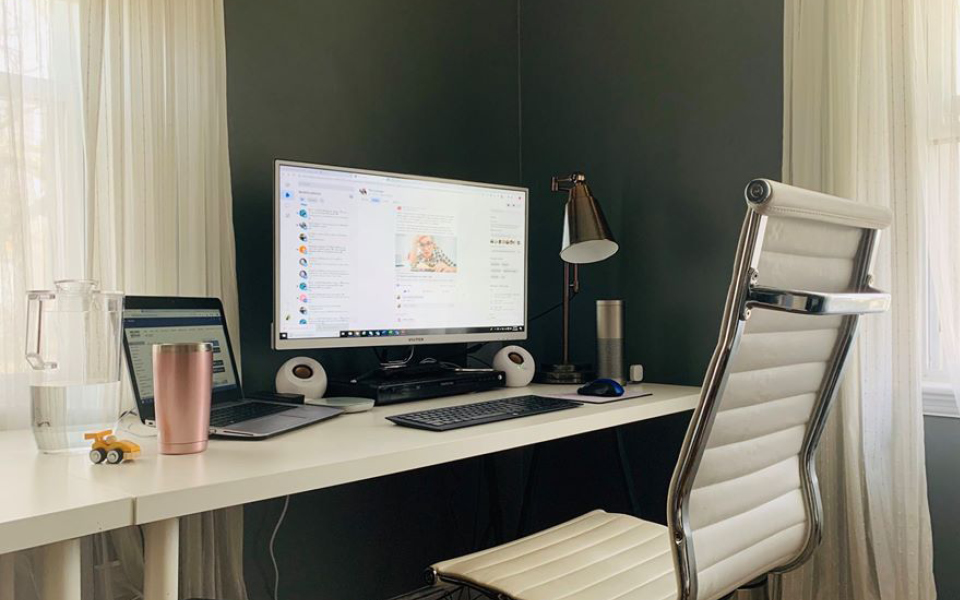
Whether you have access to a private room or you’re working within 500 square feet, make sure to carve out a dedicated space to work (that’s not your bed), so you are able differentiate your work hours with your personal time.
- Try to create a space away from other activity (you don’t want this to be a multi-functional space, if possible).
- Make your space comfortable and ergonomic. Some furniture companies have even been loaning out ergonomic desk chairs to help the transition.
- Consider your table/desk and chair height. Your legs and arms should be bent at a 90-degree angle to prevent back aches and carpal tunnel.
- Use a stool under your feet (or box, yoga block, or whatever you have handy) if your chair is too high, to bring your legs to the right position.
- Your computer screen should be an arm’s length away from you and should be placed even farther if you have a larger-than-normal screen size.
- Your eyesight should be straight forward at the screen (your eyes should be at center or 1/3 from the top of the screen), not looking down to prevent headaches. Prop up your screen with books if it isn’t high enough.
- Consider your background for video calls. Try to avoid messy or busy-looking backdrops, instead look for bookcases, organized shelving, or solid colored walls. It’s also good to have a consistent light source, either a window or lamp to the side of you, but not behind you which will make you hard to see on camera.
- Try and keep your work surface clean and organized.
- Have a notepad handy to capture meeting minutes, reminders, and ideas as they come to you throughout the day, so you don’t have to get up.
- Choose a well-lit area and think about adding a task light for additional exposure.
- If possible, face a window so you have access to natural light and a stimulating view.
- Surround yourself with plants or flowers. If you don’t have indoor plants, pick greenery from your yard, purchase a bouquet at the grocery, or even utilize fake plants to replicate the feeling of the outdoors.
- It is also important to remember all our WELL initiatives when working from home… to learn more check out our latest post on how to stay WELL while remote!
Stick to a routine

Creating a routine and sticking to it can add normalcy during this time of uncertainty. Consider these tips to help you form a routine while working from home:
- Develop a new routine as soon as possible and stick to it! Developing new habits will help you adapt to and normalize your new work environment (this can also help other family members better adjust to the change).
- Make sure you wake-up and go to bed at your normal hours.
- It is easy to lose track of time, so think about setting an alarm for breaks, meetings, or quitting time.
- It helps to get ready for the day as if you were going into the office (get out of those pajamas).
- Set a hard schedule for a lunch break and make sure to get up, walk around, and disconnect from work.
- Just like a normal day at the office, make sure to stay connected – embrace video conferencing and webcams so you can see your teammates, clients, and partners.
- It is OK to schedule online social time to have conversations with no agenda (or better yet a virtual happy hour at 5:00) … everyone needs a break throughout the day.
- Finally, make sure to give yourself something to look forward to at the end of your workday – whether that’s a glass of wine, video game time, or walking your dog in silence, let that be a daily celebration.
Take advantage of the perks
 While it might be hard to look on the bright side during this time, remote working allows us the added benefit of freedom. We have the ability to customize our work experience – whether that’s with music, scent, or location. Make sure you take advantage of it.
While it might be hard to look on the bright side during this time, remote working allows us the added benefit of freedom. We have the ability to customize our work experience – whether that’s with music, scent, or location. Make sure you take advantage of it.
- Don’t underestimate the power of scent. Light a candle, get an oil diffuser, or use incense. Finding a calming scent can help you reduce stress, to create your own Zen moment in your day.
- Play music that inspires you, calms you, or energizes you.
- Walk around while on a conference call, go outside to write an email, or sit on a comfy couch while reviewing a document – we have the ability to customize our work environment.
- Exercise at lunchtime or take your kids out to play. Remember a healthy body equals a healthy mind, so don’t forget to get some fresh air.
- Write, draw, or express creatively about the experience. Someday, this will be the story you and your kids will tell their kids or grandchildren.
Stay inspired
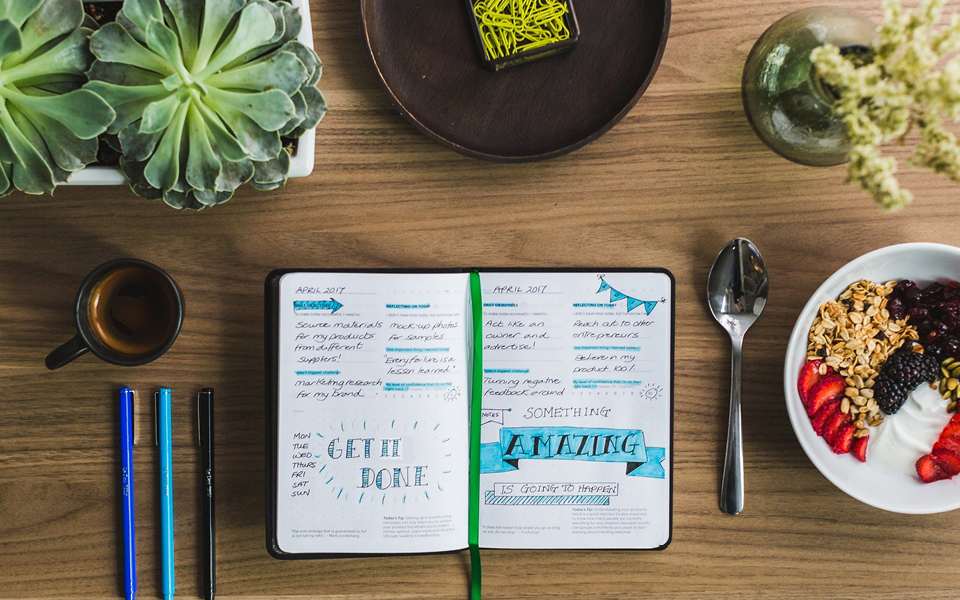
Just because we’re trapped inside, doesn’t mean we should stop learning. Check out some of the great resources below to stay motivated, curious, and creatively inspired!
- Take up to 12 virtual tours of some of the world’s most famous museums.
- Check out MailChimp’s #SupportTheShorts, a project that includes free online streaming of short films that were due to screen at SXSW, but never had a chance due to coronavirus.
- Listen to a new creative podcast like Clever, Design Matters, or 99% Invisible.
- Thanks to Creative Boom, you can download and print a fresh, new coloring book from some of the biggest names in the creative community, to give your mind a break (adult-approved).
- Want more tips on how to successfully work from home? Check out LinkedIn’s new Remote Working Series with curated content to set yourself and your teams up for success.
- Check out our Creative Fuel posts for on-going creative inspiration from the entire NELSON Worldwide team!
This post is a collaborative effort from NELSON teammates: Amy Leigh Hufford, Jenniffer Torres, Roslyn zumBrunnen, Holly Williamson, Hector Fernandez, Danijel Pocanic, Alan Dandron, and Nicole Keeler.
Part II: In The City with NELSON NYC
New York City is home to the largest population of designers in the country. Over 45,000 creatives work within the city limits each day making it a global hub for inspiration and creativity. NELSON New York is proud to be part of this community, designing some of the city’s most innovative environments, from corporate offices to retail flagships. To highlight all the exciting things going on “In The City” and at NELSON Worldwide, we’re unwrapping a three-part series that introduces some of our creative leaders and shares their thoughts on New York City’s design landscape.
Part I of our three-part In The City with NELSON NYC series introduces you to Joey Schirripa, Tenant Landlord Studio Director at NELSON NYC.
Q: Who are you as a designer? Tell us more.
As a designer, I am practical and balanced. I appreciate the visuals and aesthetics that can be accomplished by the use and manipulation of products and materials, but I am always conscious of cost, function, and longevity. This is not only important to me but the client which is why I always ask What is this going to look like day two? Is this easy to maintain? Is the design too specific to current trends that it will tire quickly?
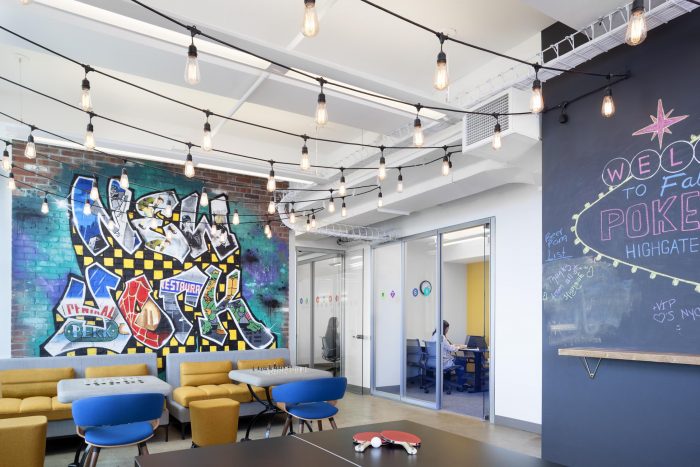
Q: 6 words that describe what it’s like to be a designer in NYC. Go!
Challenging
Interactive
Exciting
Forward-thinking
Engaging
Passionate
Q: What are some architecture and interior design trends in NYC you’re seeing at the moment?
At the moment, I am seeing the use of materials, lighting, and furniture that are multi-functional and allow plenty of flexibility within a space. We are designing interiors with the ability to be re-purposed so that users can easily adapt to changes with less movement and lower construction costs.
Q: How has the design landscape in NYC changed over time?
Over the years, design has become more open and accepting of the original structures and layouts of spaces. The brick and steel you find behind drywall is now the accent wall of a space. The rough beat up ceiling slab we use to conceal is now “perfect”. We are finding that the imperfect nature of these materials is now the finished look clients enjoy.
Q: What is the biggest challenge for design/designers in NYC?
A challenge for New York City designers and architects are is working with structural constraints within a project space. This City has a vast but unique range of architecture passed down from each era. Working around older methods and materials is always a challenge. For example, some buildings have wide column footprints used to fireproof them at the time. Our solution? We strip them down to the exposed steel and paint them. While finding these solutions may be challenging, they are also the things that make being a designer in NYC so special and exciting.
Q: What’s it like to work at NELSON NYC?
At NELSON every day is different! Being in the Tenant Landlord studio, the heart of our work is in NYC so we see it all and move very quickly. On an average day we could be in the office designing, working with brokers around the city, or standing on top of a 50-story building for review. All very exciting things that challenge my team and I to be creative and think on our feet.
The Amenity Effect: How to Create a Thriving Mixed-Use Destination
Amenities have a profound effect on the value of a building, and new unique experiences make a lasting impression for consumers, employees, hotel guests, and residents. Our mixed-use teammates set out to explore current and future amenity trends in our latest blog series, The Amenity Effect. Follow along as we dive deep into the environments where we work, shop, live, and thrive and take a closer look at the amenities that help make these environments flourish.
___________________________________________
Over the past few weeks we’ve pointed out experiential design opportunities within the realm of live, work, shop, and stay environments, and how amenities can add value to these environments.
While each of these sectors can stand on their own in the market, we are seeing an elevated interest to bring them together in mixed-use developments. As many urban dwellers of the millennial generation begin having families and settling down, they seek walkable communities with the same access to services, restaurants, grocery, and entertainment they had downtown. Gen Z seeks the same energy as a college campus, and there are older generations that seek to exchange the empty nest at the end of a cul-de-sac for a more vibrant community surrounded by entertainment, convenience, culture, and activity. Multi-family developments, both urban and suburban, can provide for those transitions.
_______________________
“There is no recipe for a great mixed-use development, but there is definitely a secret sauce. This secret sauce is blended together to create an active, engaging, and creative atmosphere, while making guests feel safe and entertained.”
—Michael T. Lentz, Managing Principal, NELSON Worldwide
_______________________
There are several combinations that go into the recipe for an engaging mixed-use development, and we’re breaking them down in this edition of The Amenity Effect:
Inclusive Connectivity
Engaging mixed-use destinations should be inclusive to all types of transportation including cyclists, pedestrians, public transportation and vehicles. Parking amenities like valet, stacked storage, personal garages, ride share nodes and lounges, car washing and detailers stations are all examples of amenities that bring value to a development. Mixed-use developments have a valid role in reducing the need for personal vehicles and encouraging alternative opportunities and amenities. Projects with walking trails, bike paths, and safe sidewalks are more inclusive and promote connectivity.
NELSON Worldwide’s project Avalon, a premier mixed-use destination located in Alpharetta, Georgia, features dedicated areas for ridesharing and public transportation. And as parking ratios went down, the team was able to transform the underutilized parking decks into valuable, usable, square-footage.
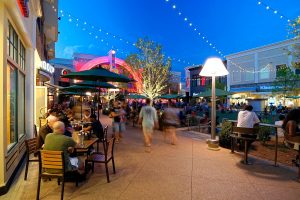
Avalon – Alpharetta, Georgia | NELSON Worldwide
Convenient Resources
Anchoring a development with a grocer or neighborhood convenience store can shore up a strong retail component, as well as provide value to the residents. Dry cleaning and laundry services add value to the multifamily components, along with style salons and pharmacies. As noted in our residential edition, more people are getting pets and we need to design for the cohabitation, care for and pampering of pets, and mingling of owners. Some seek concierge service to provide housekeeping, care service, delivery services for restaurants and groceries, and even pet sitting or walking.
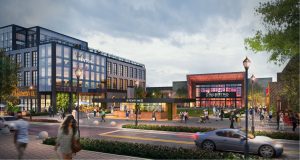
Fenton | NELSON Worldwide
Community, Creativity & Co-Working
The most lively mixed-use destinations blend community and creativity to bring energy to the environment. Amenities like community halls and event space for private events and communal gatherings bring value to those who work or live at a development.
As the work-from-home phenomenon continues, there is a paradigm shift that demands a larger variety of workspaces, going beyond traditional offices and buildings dedicated to specific companies. Now, more than ever, there is a greater need for individual and co-working space, as well as entrepreneurial lounges. Places where people can collaborate, host a presentation, or simply work remote, away from the home will see a broader market. Buildings with indoor, outdoor, and rooftop offerings, coupled with proximity to residential and restaurants aptly position these amenities.
Creating a district of offerings for creatives; a sort of Maker square can add a layer of richness to the neighborhood. A hub for boutiques and pop-up brands could co-mingle with tech startups that offer access to tools, space, and classes in 3D printing, machinery, creative software, or glass blowing for hobbyists and budding entrepreneurs. Sprinkle in options for the food and beverage arts with cooking and mixology demonstrations.
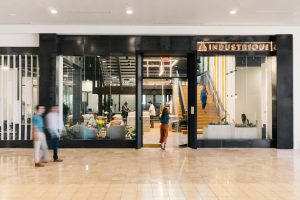
Industrious – Scottsdale, AZ | NELSON Worldwide
Flexibility to Meet Consumer Demands
The pandemic has reinforced the need for spaces that are easily converted to different uses depending on what the current needs are. Providing pop-op or quick build opportunities for local startup boutiques, can change up the experience with short-term leases to cycle in new experiences of food, retail, and health and fitness.
With the rapid growth of e-commerce and a global pandemic causing retail developments to limit capacity or temporarily close, transforming underutilized space into creative pickup and return concepts is a clever and valuable way to meet consumer demands now and in the future. There is a real planning shift in how we design street scape, traffic flow to handle merchandise pickup and returns. Developers can provide a controlled, branded experience by setting up automated storage pods throughout allowing shoppers to quickly drop off returns or pick up orders without having to go inside a crowded store. Balanced solutions can be planned for within our mixed-use developments with flexible design that can handle adversity to swiftly adapt and evolve through the next pandemic or natural disaster.
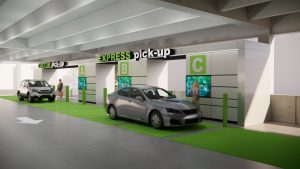
Curbside Services- Parking Garage Parcel Pickup pods | NELSON Worldwide
Ghost kitchens continue to fill market demand within communities, whether it’s for office event catering or a family meal. While the exit of anchor tenants within shopping centers are providing real estate potential for third-party food delivery concepts, there are opportunities within a mixed-use project located in areas that may not be suitable for traditional tenants due t a lack of foot traffic or visibility. Leveraging the localized delivery efficiency can serve as a valuable amenity to a neighborhood.
Recreational Hobbies
Fitness opportunities such as rock climbing, CrossFit, and yoga are traditional staples that have found their way into retail settings over the years as the activities have become more popular. However, more of these active hobbies like racquetball, tennis, pickleball, and cornhole are becoming more desirable. Adding these perks to a development differentiate it from others around it, while adding value to the overall community.
In addition, youth travel sports programs have long had a need for facilities within proximity of family lodging, food and beverage, and entertainment, so mixed use developments could promote a valued partnership. Field house buildings can provide for baseball, basketball, volleyball, soccer, golf simulators, and batting cages. Creative nuances are sometimes all it takes to transform a standard amenity to an epic one.

Nike’s headquarters in Beaverton, Oregon took a standard track design that traditionally has an open infield and with a simple gesture, threaded it through the woods, creating a unique running experience. Blurring the lines of traditional will also be seen more in seasonal environments. Summer jogging trails and kids’ parks could transition to a winter wonderland by converting a winding trail to ice skating like The Central park Ice skating trail in Maple Minnesota. Allowing year-round activation promotes outdoor wellness as well as business for the local vendors.
Wellness
In recent years we’ve noticed a dramatic shift in the way consumers view healthcare. In an era of self-care and “treat yourself” mantras, healthcare is no longer seen just as treatment for an illness or injury. The meaning now expands to beauty, wellness, fitness, and more, and consumers are demanding these services be more accessible. And according to CB Insights, the global wellness industry is worth almost $4 trillion.
Other examples of health-centric concepts for mixed-use developments are what we call medi-retail offerings. Most of the time, hospitals and health clinics are far away from the city center, with inconvenient parking, and long wait times for appointments. Malls and other retail settings make sense because of their location, ease of access, and dark anchor space, making it a win-win collaboration.
Medi-retail tenants come in all shapes and sizes. From pharmacy extensions and alternative health solutions, to dispensaries and boutique fitness centers, medi-retail opportunities run the gamut.
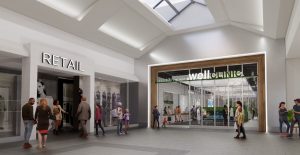
Medi-Retail Concept | NELSON Worldwide
Mixed-use projects can highlight the features in design supporting our environment and celebrate the invisible amenity features that enhance our experiences, through Wellness integration. Developers can drive green initiatives for carbon reduction goals by responsible and calculated material sourcing and energy efficiency. A centralized cooling plant can free up rooftops that traditionally house equipment allowing those rooftops to support green roof amenities. We can elevate workspaces, lounges, fitness and recreation to capture views or an urban farm atop that parking garage. New building materials and systems can reduce noise and utility bills, while improving indoor air quality that tenants and owners will buy into.
_______________________
“We don’t just reduce our energy consumption to save money, we do it because we care to have a healthy enough planet that enables us to have commerce and therefore buildings to operate our businesses within.”
—Nicole Keeler, Director of Sustainability, NELSON Worldwide
_______________________
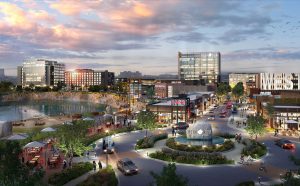
Rock Row – Westbrook, Maine| NELSON Worldwide
Rock Row located just outside Portland, Maine is an example of local repurpose and transformation. An existing quarry was transformed to provide unique amenity offerings for water recreation, trails and a light and water show called the quarry spectacular.
Programing events with a variety of options to fill the calendar year-round has been fruitful for many mixed-use developments. Coordination of schedule for holiday events, fitness programs, kids crafts, auto shows, movie nights, artist guilds, farmers’ markets, live music, fashion shows, game day tailgates, and more is key to keeping a well-oiled machine. Harnessing social media can leverage the FOMO culture by creating must have experiences. Many centers look to set up, look-at-me now installations like murals, sculptures, and interactive showpieces for those Instagram selfies which in-turn drive traffic. Designing in technology and infrastructure to support the activities of today and planning for tomorrow is important to activate and coordinate with other areas of the center to give people real experiential amenities.
A diverse and active community will continue to be the cornerstone of a successful mixed-use development for decades to come and it will be the evolution of the experiences we collaboratively create that will make them thrive.
_______________________
“Amenities are often the driver which transforms a ‘place’ into a ‘destination’ providing a range of service, comfort, and unexpected delight. Coupled with a program of events, well thought out amenities have a direct impact on dwell time and return visits.”
—Eric Arter, Vice President, NELSON Worldwide
_______________________
Part I: In The City with NELSON NYC
New York City is home to the largest population of designers in the country. Over 45,000 creatives work within the city limits each day making it a global hub for inspiration and creativity. NELSON New York is proud to be part of this community, designing some of the city’s most innovative environments, from corporate offices to retail flagships. To highlight all the exciting things going on “In The City” and at NELSON Worldwide, we’re unwrapping a three-part series that introduces some of our creative leaders and shares their thoughts on New York City’s design landscape.
Part I of our three-part In The City with NELSON NYC series introduces you to Holly Williamson, Design Director and member of our Global Solutions team.
Q: Who are you as a designer? Tell us more.
As I grow as a designer I lean towards classic design that won’t look trendy in years to come. I like playing with materiality, texture, neutral colors and lighting to make spaces memorable. Mentoring young designers is very important to me, they bring fresh ideas and a different perspective. I encourage everyone to bring their design ideas to the table, even odd ball ideas might lead you to the final design solution. See a few of our latest and greatest projects below (some complete and some coming soon)!
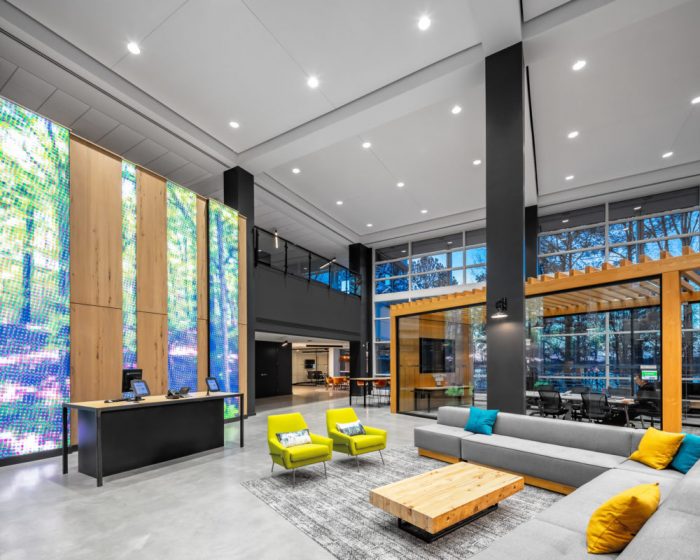
Q: 6 words that describe what it’s like to be a designer in NYC. Go!
Fast.
Fun.
Creative.
Energizing.
and Exhausting,
BUT AMAZING!
Q: What are some architecture and interior design trends in NYC you’re seeing at the moment?
Clients are embracing the blending of hospitality and retail into corporate interiors which allows us so many great opportunities for creative spaces. More workplace clients are understanding the importance of integrating outdoor spaces to work/dine in. Many Global Solution clients are turning away from one size fits all design and instead focusing on local design concepts to help make the spaces unique to help attract and retain talent and help define the brand. This can be anything from local artwork, locally sourced materials/furniture, to custom Environmental Graphics Branding that showcases the area or even brining in local restaurants to cater in their cafeterias or pop up cafes/food truck days.
Q: How has the design landscape in NYC changed over time?
I came to New York in the early 2000s after spending time in San Francisco during the dot com boom. I felt that New York was not nearly as forward-thinking as San Francisco was then. So much of New York still had the “I need the corner office” mentality. I feel that NYC is pushing boundaries and creating positive change in workplace design. It helps that many tech companies have offices in NY to help push the needle
Q: What are your favorite types of projects to work on?
I enjoy working on large scale corporate projects with multiple amenity spaces. I love to develop the overall concept for a space with many functions. Activating all portions of the building is an exciting challenge and allows for special moments to focus in on. We recently completed a corporate campus in Raleigh/Durham and it had: a full-service cafeteria, tech help desk, barista bar, fitness center, multiple micro-markets, a training center, Executive Briefing Center, outdoor walking paths and numerous: wellness rooms, pantries, coffee bars & outdoor terraces/patios throughout the project.
Q: What’s it like to work at NELSON NYC?
Working at NELSON is fun! Every day is a new day for me. As Design Director I’m fortunate to oversee many different clients and each one has its own unique design stamp. The success of the projects really comes from everyone involved on our team. From juniors all the way up to senior staff, we work hard to exceed our client’s expectations, and everyone is encouraged to bring their ideas and challenge themselves. I also feel fortunate to be part of a larger organization where my counterparts in other offices are reliable sounding boards and friends. I’ve had the opportunity to work with designers from around the country exposing me to endless creative ideas and fresh approaches.
Asset AdvantEDGE: Redefining Amenities
In recent years, physical amenities have become an imperative perk to differentiate your property’s experience, but the rise of COVID-19 has shifted consumer behavior and the role of the workplace (check out our post on Top 10 COVID-Safe Amenities). Soon, pressure for employees to return to the office full time will ease and it will be up to landlords to create a differentiated foundation for programming, engagement, and collaboration that tenants not only want to return to but cannot be replicated at home. The traditional definition of amenities will expand to support lifestyles – both in and outside the property – and successful future perks will be a blend of digital offerings and experiential environments, as our teammate Holly Williamson recently shared with the New York Real Estate Journal.
Download a PDF of this newsletter
Leading Regional Trends: Northeast | Southeast | Central | West
Good Reads | Featured Project
Northeast: Urban Convenience
Even post-pandemic, urban hubs in the Northeast will still value convenience in their workplace offerings. From secure bike rooms to commute-tracking apps, the focus will be on ease of experience, as much as safety. With public transit still a concern, offices should consider adding perks like an Uber allowance or electric scooter rentals for alternative transportation options. Landlords might even consider offering additional square footage in satellite buildings to give tenants and employees more flexibility in where they go to work, providing a dedicated network rather than a dedicated office. Consider conducting tenant surveys to understand your commute breakdown to provide more relevant offerings.
[ngg src=”galleries” ids=”9″ display=”basic_imagebrowser”]
Southeast: Foodie Focus
The foodie culture of the South will need to be reimagined in the wake of the pandemic. Landlords will need to get creative to offer a differentiated food and beverage experience for their tenants, with safety in mind. Consider win-win partnerships with local restaurants, food trucks, catering apps like Relish, and even cloud kitchens, to offer employees unique, localized food offerings in a more controlled environment. Create dedicated drop-off zones for food delivery with warming drawers, refrigerators, and disposable utensils to reduce touches and streamline the process.
[ngg src=”galleries” ids=”10″ display=”basic_imagebrowser”]
Central: All Season Entertainment
Now that tenants have been forced to embrace the working from home experiment, the role of the office is shifting. While heads-down work can easily be accomplished at home, the office will be need to be transformed into a social destination – an experiential hub for brands, dedicated to hosting clients, encouraging employee engagement, and facilitating teammate collaboration – and amenities will need to follow suit. Consider creating more elevated, year-round spaces that can flex depending on the occasion and get employees excited about an excuse to return to the office.
[ngg src=”galleries” ids=”11″ sortorder=”88,87″ display=”basic_imagebrowser”]
West: Wandering Wellness
A healthy lifestyle is nothing new in this region, but a renewed focus on holistic, outdoor wellness will reign supreme in the coming years. Create differentiated amenities like hiking trails, dedicated meditation areas, or artificial turf for multi-purpose events and activities, to allow your tenants to unwind and recharge in a safe environment. If you’re short on square footage, consider app subscriptions for on-demand content like Headspace, LulaFit, or Peloton.
[ngg src=”galleries” ids=”12″ display=”basic_imagebrowser”]
Working with you, to get you back to work
SPARC: Space Planning & Assessment in Response to COVID
As we collectively transition into the next phase of COVID-19 containment, we’re here to guide you through the process of assessing your space based on your company’s approach to returning to your workplace. Our tiered service packs allow you to quickly assess your needs and identify what’s right for you.
Good Reads
- 10 COVID-Safe Building Amenities
- Reimagining amenities for the future of workplace
- LulaFit adjusts to coronavirus crisis by shifting to virtual amenities programs
- The best workplace amenities are the ones your employees don’t even notice
- Food is a big deal at work. Here’s how the pandemic will change lunch and snacks
- A place to meet, a place to relax: what members want from their workspace
- Fitbit rolls out ‘Ready for Work’ COVID-19 symptom tracker
- The amenity evolution
- The future of work is hybrid: Work from home and the workplace
- The amenity effect: making your office building more marketable
Featured Project: Nomad Tower
We reimagined this 39-story building in New York City’s upcoming neighborhood known as NoMad, located north of Madison Square. Elevated amenity spaces including a private lounge complete with ping pong, pool table, and arcade games. In addition, tenants can take advantage of a conference room, 200-person amphitheater, fitness center, private coffee bar, and New York’s largest bicycle storage and bicycle access to an office building.
[ngg src=”galleries” ids=”13″ display=”basic_thumbnail” override_thumbnail_settings=”1″ thumbnail_width=”200″ thumbnail_height=”200″ thumbnail_crop=”1″]
See full project details View Asset Strategy
Return to Work Survey
Evolving Workforce Expectations
Learn more about NELSON Worldwide’s proprietary research study on emerging employee expectations to better determine the impact COVID-19 has had on work environments and employee engagement. We uncover insights that will help drive your re-entry strategy and provide support and context for future decisions.
Stay In the Know
Work After COVID-19: Connection, Culture, and Reputation
Our desire to connect is a survival instinct
Even before COVID-19, loneliness was considered a public health problem by cognitive and social scientists. While many employees have thrived in the new reality of working from home, many have also struggled with a sense of isolation and loss of connectedness with their co-workers.
Humans are primates, and in the competition for survival, the practice of living in societies where resources, information, and protection are shared has provided humanity a distinct advantage. The modern workplace is also an intimate social group where cooperation and interaction with other group members play a crucial role in our business survival. Our yearning for the camaraderie of the workplace is part of our survival instinct.
Humanity is currently engaged in a purposeful evaluation of what we’ll allow back into our lives post-pandemic. That evaluation will impact our expectations of businesses and brands. We can expect to see the previous standards, expectations, and behavioral patterns of workers to evolve rapidly. The shutdown accelerated an already massive shift toward mobility and remote working. Workplaces will need to support smaller onsite and remote team interactions.
Decompressed density means that some of us will be working remotely, and some will work in shifts.
We believe that employer brands will move beyond a focus on recruitment and retention strategies toward a more integrated and holistic influence on the fulfillment of overall brand objectives.
Extraordinary times, require extraordinary resolve
As organizations face uncertainty, the need to reinforce the business’s core drivers becomes even more critical. Inspiring loyalty and driving performance are easier when employees care about what you do, understand your values, and are genuinely inspired by your vision and purpose.
The boundaries between being physically in the office and out of the office are collapsing. We envision a “redefined essentialism” in the design of future workplaces, dispensing with practices and tools that no longer serve the future. Reinventing these spaces to become epicenters for organizational priorities, building social networks, and organizational development. Developing fit-for-purpose workplaces will make them the driving force behind collaboration and collective intelligence.
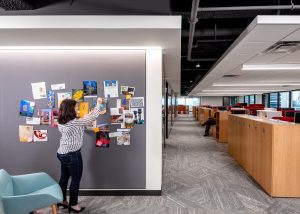
The Trust Ecosystem
When the world seems precarious and uncertain, a resilient organization becomes even more important. Organizations who operate with a shared sense of purpose and trust are more capable of swiftly adapting to change. A Watson Wyatt study shows that high-trust organizations outperform low-trust organizations by 286% in total return to shareholders.
“Trust is not merely a soft, social virtue; rather, trust is a pragmatic, hard edged, economic, and actionable asset that you can create.” Stephen M.R. Covey
Deloitte Insights describes the four dimensions of trust as physical, emotional, financial, and digital. Post–COVID-19, business leaders can future proof their business by creating strategies that take the needs of all stakeholders into consideration, across these four dimensions.
Here are the ways the four facets of trust can inspire the future role of winning employer brands and workplaces in the pre-Vaccine COVID-19 era.
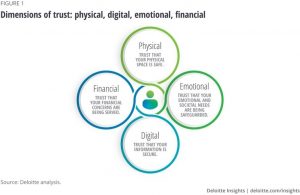
Physical Trust
The workplace has a unique opportunity and responsibility to become a safe haven. Provide visible solutions for sanitation and germ mitigation, reassuring guests and employees they are safe. Leverage tactics inspired by WELL Building Standards, the office can become the trusted environment employees need.
Emotional Trust
Increase cooperation between marketing and HR brand stakeholders to create holistic solutions that build upon each other. Create symbols of trust to nurture a shared sense of connection and solidarity. Provide reliable alternatives to connecting face-to-face and enhance remote work capabilities. Amplify opportunities for collective initiatives that uplift everyone and reinforce a shared vision for success.
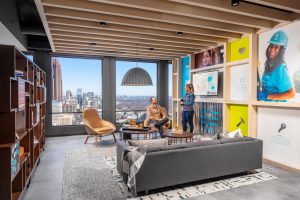
Financial Trust
Reassure employees with transparent communications around business health, company plans, and intentions. Help them understand that as the economy and business recover, so, too, will employee pay. Extend trust and empower autonomy to demonstrate your loyalty and confidence.
Digital Trust
With more remote work, employees will be concerned that their work-related and personal data are secure and private. Invest in behind-the-scenes solutions, systems, and network infrastructures to create a flexible workplace that adapts to the new reality.
As we seek to normalize operations, employers will be held accountable for operating with integrity and empathy, standing for something, and taking responsibility. The connection between brand purpose, culture, trust, and values is more evident than ever before. Prioritizing connection, culture and reputation enables organizations to prosper in uncertain times.
Building Resilient Infrastructure: A Guide for Government Buyers
As natural disasters become more frequent and intense, government buildings are increasingly at risk. From wildfires and hurricanes to floods and earthquakes, the stakes have never been higher for cities, counties, and states to ensure that their infrastructure is resilient and can continue serving the public in the face of these challenges.
The need for resilient architecture goes beyond environmental concerns—it’s a financial necessity too. The National Institute of Building Sciences highlights that every dollar spent on resilience saves $6 in future recovery costs. For government agencies, investing in disaster-resistant infrastructure is an opportunity to protect citizens and make long-term, cost-effective improvements to public buildings.
Tailored Solutions for Key Government Roles
Each government role plays a vital part in ensuring that buildings are not only resilient but also efficient and cost-effective. Here’s how different stakeholders can make a significant impact:
- Procurement Officers
Streamline purchases by working with pre-approved vendors specializing in resilient materials and use procurement frameworks that prioritize disaster preparedness. - Contracts Managers
Embed resilience clauses in contracts to ensure vendors meet sustainability and disaster resilience standards, with flexibility for future upgrades. - Government Buyers
Evaluate long-term savings with cost-benefit analysis tools to prioritize energy-efficient designs and adaptive reuse, demonstrating the value of resilience investments. - Supply Chain Directors
Focus on local sourcing and develop emergency procurement plans to ensure critical materials are readily available during crises. - Purchasing Managers
Use tiered pricing models and bulk purchasing options to provide scalable solutions for projects of all sizes, aligning with resilience goals.
Resilience Solutions for Key Government Sectors
Every government building faces its own set of challenges when it comes to resilience. Here’s a look at some of the specific needs for different sectors:
- Emergency Operations and Public Safety Buildings: Power outages, extreme weather, and the need for uninterrupted operations make these buildings a priority. Solutions include energy resilience (solar panels and battery storage), seismic retrofitting, and floodproofing measures like elevated foundations and flood barriers.
- Courthouses and Municipal Government Buildings: These buildings must maintain continuous operations, including judicial proceedings. Adaptive reuse of older buildings, smart technologies for real-time disaster response, and redundant systems (like backup power and data storage) are key to ensuring smooth operations during a crisis.
- Public Health Facilities and Emergency Shelters: These buildings often need to accommodate surges in demand during emergencies. Modular construction for adaptable spaces, reliable backup systems for water and HVAC, and repurposing non-essential buildings as shelters are solutions that can keep these facilities running smoothly.
Funding Opportunities to Support Resilience
Securing funding for resilience projects can be a challenge, but there are several programs available to help.
- FEMA’s Building Resilient Infrastructure and Communities (BRIC) program provides grants for pre-disaster mitigation, including flood protection and energy resilience projects.
- The Department of Energy (DOE) offers grants for energy solutions, such as solar panels, microgrids, and battery storage.
- The U.S. Department of Housing and Urban Development (HUD) provides grants through its Community Development Block Grant Disaster Recovery (CDBG-DR) program to support the construction of resilient municipal buildings.
The Future of Resilient Infrastructure
The future of resilient infrastructure is being shaped by emerging technologies. 3D printing, for instance, offers cost-effective, durable construction options that can be deployed quickly. Smart building systems, like automated flood detection and energy optimization, are transforming how buildings respond to emergencies. Modular construction continues to gain popularity as it allows for adaptable, scalable designs that can evolve with changing needs.
How to Get Started
If you’re ready to start building resilient infrastructure, the first step is conducting vulnerability assessments to identify which buildings are most at risk. Then, create a resilience roadmap to guide the integration of advanced technologies and smart solutions. Securing funding through grants and working with architectural experts will be crucial in moving your projects forward. From there, prioritize high-risk buildings and implement smart technologies for ongoing resilience monitoring.
Ready to take the next step?
Investing in resilient infrastructure today is an investment in the safety and future of our communities. By leveraging advanced solutions, securing funding, and aligning with the right stakeholders, government clients can create buildings that not only survive but thrive in the face of increasing natural disasters.
Contact us today to discuss how we can help you build a resilient infrastructure for your government buildings.